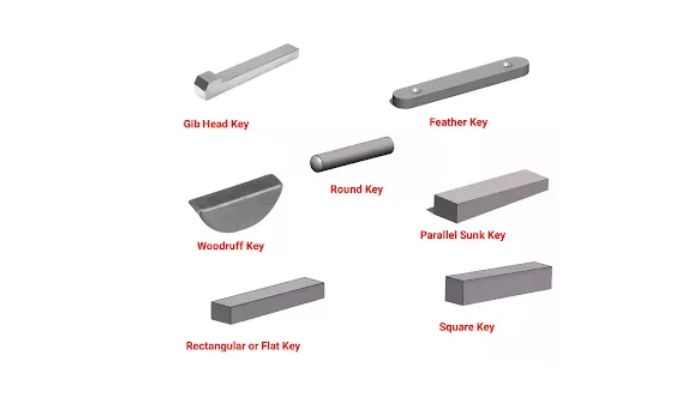What is Shaft Key?
When rotating a pulley, gear, etc., via a machine’s shaft, a shaft key serves to establish the connection between the pulley, gear, and the shaft.
By connecting the gear and pulley with a shaft key, both components effectively merge, ensuring that when one part rotates, the other rotates concurrently.
Typically crafted from steel, the shaft key is consistently fitted parallel to the axis of the shaft.
Considered a type of temporary fastener, the shaft key plays a crucial role in facilitating the rotational connection between various components.
What is Keyway?
What is Sunk Key?
A sunk key is a type of key where one-half of the key is inserted into the keyway of the pulley, while the remaining half is situated within the keyway of the shaft.
Types of Sunk Key
- Gib Head Key
- Feather Key
- Woodruff Key
- Parallel Sunk Key
- Rectangular or Flat Key
- Square Key
- Round or Circular Key

Gib Head Key
This type of sunk key features a head at one end known as the Gib Head.
The key can be effortlessly applied or removed by gripping this head.
In this sunk key variant, the head serves to minimize the impact of the hammer, thereby preventing damage to the shaft.
The gib head key exhibits a taper ratio of 1:100 in thickness.
Primarily utilized for securely fastening gears and pulleys onto the shaft, these keys play a crucial role in ensuring a tight and reliable connection.
Feather Key
Woodruff Key
The upper portion of the Woodruff key has a flat surface, while the lower section is semicircular.
The Woodruff key possesses the ability to tilt and align itself in accordance with the shaft.
To accommodate the Woodruff key, the keyway needs to be deeper, ensuring a secure fit and preventing any slippage between the shaft and hub.
Primarily employed to enhance the concentricity of the shaft during high-speed rotation, Woodruff keys play a crucial role in maintaining stability.
Parallel Sunk Key
Parallel sunk keys come in either rectangular or square sections, lacking any taper.
These keys are cost-effective and readily accessible.
Read also: Are PET Bottles Safe for us and the environment?
Parallel keys find extensive use in the manufacturing and automotive sectors, thanks to their affordability and straightforward installation process.
Rectangular or Flat Key
Rectangular keys, also known as flat keys, have a width greater than their height.
They are commonly recommended for shafts with a diameter of around 20 inches.
Square Key
Square keys, as the name suggests, have a square cross-sectional shape and are suitable for larger shafts.
In square sunk keys, the width and thickness dimensions are equal.
These keys are commonly recommended for shafts with a diameter ranging from 0.25 to 1.0 inches, although larger square keys are also available for shafts up to 6.5 inches in diameter.
Round or Circular Key
Circular keys have a round cross-sectional shape and are partially inserted into both the hub holes and the shaft.
A significant advantage of using round keys is that their key drill can be re-drilled after assembling the mating parts.
These keys are typically well-suited for low-power drives.
The round key has a taper of 1:50.
Advantages of Sunk Key
- The sunk key exhibits a high power transmission capacity compared to other types of keys.
- It provides a positive drive, ensuring that no slipping occurs.
Disadvantages of Sunk Key
Uses of Sunk Key
- Sunk keys find applications in various industrial machinery.
- especially in machine tool settings.
I trust that I have provided comprehensive information on the “sunk key.” Should you have any further doubts or questions about this topic, feel free to reach out to me directly or inquire through the comments. I am committed to responding promptly.
Read also: Types of Cutting Tool Materials and Their Properties
If you found this article helpful, consider sharing it with your friends to extend the knowledge.
Thank you.
Admiring the haгd work you put into your website and in depth
information you provide. It’s nice to come acгoss a blog every
once in a while that isn’t the ѕame unwanted rehashed information. Fantastic read!
I’ve Ƅookmarkeⅾ your site and I’m including your RSS feeds to my Google account.